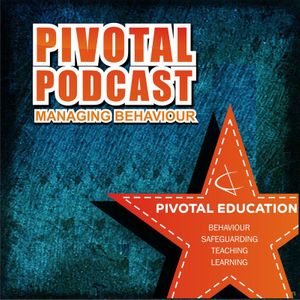Do we know enough about Inclusion? Tara Elie speaks to Emma Brown – PP204
Pivotal Podcast - A podcast by Pivotal Education

Categories:
Tara Elie is back on the podcast this week after about a year away! She speaks to Emma Brown, a Practice Development Coach working in Social Care with clients who have learning disabilities and/or Autism. She shares a great deal of her knowledge which is equally applicable to those in mainstream settings who come into contact with children with learning disabilities and/or Autism. Emma works with the teams who support people with learning disabilities in their homes, to help them to live as independently as possible. She provides training and coaching for the teams. Positive Behaviour Support Teams Positive behaviour support works by measuring the function of someone’s behaviour. The data generated helps to identify the reasons for that behaviour and its patterns so we can help clients better. Often the problems Emma sees are linked to the type of support the person is receiving. It’s easy to implement interventions or support which actually exacerbate the behaviour and the Positive Behaviour Support Teams can help with identifying some of these problems. What Positive Behaviour Support Teams look for Emma says there are many things the teams look for: * The culture * Values * Behaviours * Whether guidelines are being followed * Team coherence * Communication methods * Consistency * Quality of team management A good support worker would be somebody who perceives that the person they are supporting is equal to them and as valuable as anybody else. Person-centred Active Support This idea developed out of previous culture of support workers doing far too much for the clients and therefore being left with nothing to do for large amounts of the day. They became disengaged and bored. Person-centred Active Support is about engaging people to be involved in their own lives – in meaningful activities. This could be as simple but important as taking the bins out. Communication Often the communication styles we favour are not the ones which work best for people with learning disabilities and/or Autism. Speech is the most complicated way of communicating and once the sentence has come out of your mouth it no longer exists. People with Autism thrive when they have visual types of communication as well as verbal communication. We should back verbal communication up with other kinds of communication such as: * Sign language such as Makaton * Symbols such as line drawings of objects * Photographs of objects * Objects of reference which are particularly good for people with severe learning dificulties The client’s preferred method of communication can be more effectively delivered as a sequence. Emma describes a physical timetable which uses symbols which can be removed and placed in an attached container as each part of the day passes. This kind of approach improves Independence as it removes the need to ask continuously, “What’s happening next?” How can we get children with learning disabilities and/or Autism to stop being ‘naughty’ When someone is being ‘naughty’ they are trying to communicate something. If we can realise the behaviour is not happening for no reason, we can look at behaviour from a different standpoint. People with Autism might be struggling in a classroom situation for a wide variety of different reasons – and they may not be consistent day-to-day. Emma recommends these resources from the National Autistic Society website.